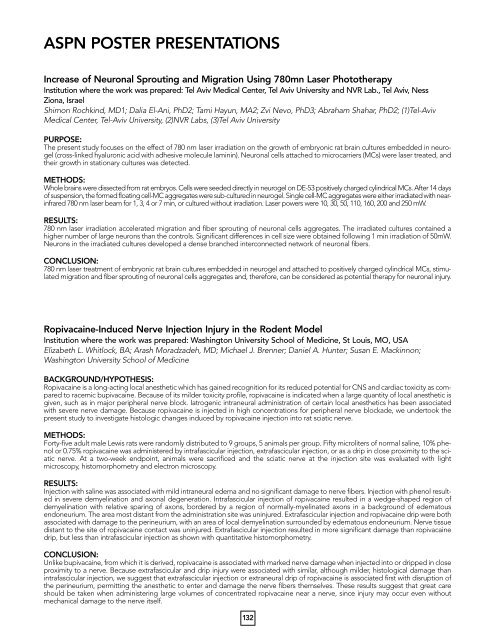Floor plan - 2013 Annual Meeting - American Association for Hand ...
Floor plan - 2013 Annual Meeting - American Association for Hand ...
Floor plan - 2013 Annual Meeting - American Association for Hand ...
You also want an ePaper? Increase the reach of your titles
YUMPU automatically turns print PDFs into web optimized ePapers that Google loves.
ASPN POSTER PRESENTATIONS<br />
Increase of Neuronal Sprouting and Migration Using 780mn Laser Phototherapy<br />
Institution where the work was prepared: Tel Aviv Medical Center, Tel Aviv University and NVR Lab., Tel Aviv, Ness<br />
Ziona, Israel<br />
Shimon Rochkind, MD1; Dalia El-Ani, PhD2; Tami Hayun, MA2; Zvi Nevo, PhD3; Abraham Shahar, PhD2; (1)Tel-Aviv<br />
Medical Center, Tel-Aviv University, (2)NVR Labs, (3)Tel Aviv University<br />
PURPOSE:<br />
The present study focuses on the effect of 780 nm laser irradiation on the growth of embryonic rat brain cultures embedded in neurogel<br />
(cross-linked hyaluronic acid with adhesive molecule laminin). Neuronal cells attached to microcarriers (MCs) were laser treated, and<br />
their growth in stationary cultures was detected.<br />
METHODS:<br />
Whole brains were dissected from rat embryos. Cells were seeded directly in neurogel on DE-53 positively charged cylindrical MCs. After 14 days<br />
of suspension, the <strong>for</strong>med floating cell-MC aggregates were sub-cultured in neurogel. Single cell-MC aggregates were either irradiated with nearinfrared<br />
780 nm laser beam <strong>for</strong> 1, 3, 4 or 7 min, or cultured without irradiation. Laser powers were 10, 30, 50, 110, 160, 200 and 250 mW.<br />
RESULTS:<br />
780 nm laser irradiation accelerated migration and fiber sprouting of neuronal cells aggregates. The irradiated cultures contained a<br />
higher number of large neurons than the controls. Significant differences in cell size were obtained following 1 min irradiation of 50mW.<br />
Neurons in the irradiated cultures developed a dense branched interconnected network of neuronal fibers.<br />
CONCLUSION:<br />
780 nm laser treatment of embryonic rat brain cultures embedded in neurogel and attached to positively charged cylindrical MCs, stimulated<br />
migration and fiber sprouting of neuronal cells aggregates and, there<strong>for</strong>e, can be considered as potential therapy <strong>for</strong> neuronal injury.<br />
Ropivacaine-Induced Nerve Injection Injury in the Rodent Model<br />
Institution where the work was prepared: Washington University School of Medicine, St Louis, MO, USA<br />
Elizabeth L. Whitlock, BA; Arash Moradzadeh, MD; Michael J. Brenner; Daniel A. Hunter; Susan E. Mackinnon;<br />
Washington University School of Medicine<br />
BACKGROUND/HYPOTHESIS:<br />
Ropivacaine is a long-acting local anesthetic which has gained recognition <strong>for</strong> its reduced potential <strong>for</strong> CNS and cardiac toxicity as compared<br />
to racemic bupivacaine. Because of its milder toxicity profile, ropivacaine is indicated when a large quantity of local anesthetic is<br />
given, such as in major peripheral nerve block. Iatrogenic intraneural administration of certain local anesthetics has been associated<br />
with severe nerve damage. Because ropivacaine is injected in high concentrations <strong>for</strong> peripheral nerve blockade, we undertook the<br />
present study to investigate histologic changes induced by ropivacaine injection into rat sciatic nerve.<br />
METHODS:<br />
Forty-five adult male Lewis rats were randomly distributed to 9 groups, 5 animals per group. Fifty microliters of normal saline, 10% phenol<br />
or 0.75% ropivacaine was administered by intrafascicular injection, extrafascicular injection, or as a drip in close proximity to the sciatic<br />
nerve. At a two-week endpoint, animals were sacrificed and the sciatic nerve at the injection site was evaluated with light<br />
microscopy, histomorphometry and electron microscopy.<br />
RESULTS:<br />
Injection with saline was associated with mild intraneural edema and no significant damage to nerve fibers. Injection with phenol resulted<br />
in severe demyelination and axonal degeneration. Intrafascicular injection of ropivacaine resulted in a wedge-shaped region of<br />
demyelination with relative sparing of axons, bordered by a region of normally-myelinated axons in a background of edematous<br />
endoneurium. The area most distant from the administration site was uninjured. Extrafascicular injection and ropivacaine drip were both<br />
associated with damage to the perineurium, with an area of local demyelination surrounded by edematous endoneurium. Nerve tissue<br />
distant to the site of ropivacaine contact was uninjured. Extrafascicular injection resulted in more significant damage than ropivacaine<br />
drip, but less than intrafascicular injection as shown with quantitative histomorphometry.<br />
CONCLUSION:<br />
Unlike bupivacaine, from which it is derived, ropivacaine is associated with marked nerve damage when injected into or dripped in close<br />
proximity to a nerve. Because extrafascicular and drip injury were associated with similar, although milder, histological damage than<br />
intrafascicular injection, we suggest that extrafascicular injection or extraneural drip of ropivacaine is associated first with disruption of<br />
the perineurium, permitting the anesthetic to enter and damage the nerve fibers themselves. These results suggest that great care<br />
should be taken when administering large volumes of concentrated ropivacaine near a nerve, since injury may occur even without<br />
mechanical damage to the nerve itself.<br />
132



